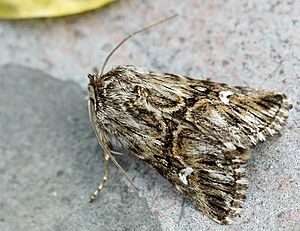Toadflax moth facts for kids
Quick facts for kids Calophasia lunula |
|
|---|---|
 |
|
| Scientific classification |
The Calophasia lunula is a type of moth found across Europe and Asia. It is often called the toadflax moth or toadflax brocade moth. This moth is known for its caterpillars, which eat plants called toadflax.
Contents
Where the Toadflax Moth Lives
The Calophasia lunula moth lives in many parts of Europe, including central and southern areas. It also spreads across Russia and into Central Asia and the Russian Far East. You won't find this moth in Japan.
This moth has also been brought to parts of Canada and the United States. In mountain areas like the Alps, it can live at heights up to 2000 meters (about 6,500 feet). These moths prefer warm, open areas like sunny hillsides and wild lands.
Life Cycle of the Toadflax Moth
The female moth lays between 30 and 80 eggs. She places them on the leaves and flowers of toadflax plants. After one to two weeks, a tiny larva (or caterpillar) hatches from each egg.
Caterpillar Growth
The young caterpillar starts eating the plant right away. It grows for about a month. During this time, it sheds its skin five times. This process is called molting.
When it first hatches, the caterpillar is about 5 millimeters long and dark gray. As it gets older, it becomes much more noticeable. Older caterpillars are black and white with bright yellow stripes. A fully grown caterpillar can be about 4 centimeters long.
Pupa Stage
Once the caterpillar is fully grown, it enters the pupa stage. It builds a cocoon using chewed plant bits and fallen leaves. The moth then stays in this cocoon through the winter.
How the Toadflax Moth Helps Plants
The caterpillars of the toadflax moth are very hungry eaters. They first munch on the new leaves and flower buds. Then, they move on to eat the stems, older leaves, and flowers. They can eat so much that they completely strip large numbers of toadflax plants.
While this usually doesn't kill the plants, it makes it very hard for them to produce seeds. This means fewer new toadflax plants will grow. Adult moths, however, only drink nectar from flowers. They do not harm the plants.
Using Moths to Control Weeds
The toadflax moth is used in a special way called biological pest control. It helps control two types of toadflax plants: yellow toadflax and Dalmatian toadflax. These plants are considered harmful weeds in North America.
The moth was first brought to Canada in the early 1960s to help with weed control. It was introduced to the United States shortly after. Now, the moth lives in many areas where these weeds are a problem. However, it doesn't do as well in very cold places.


